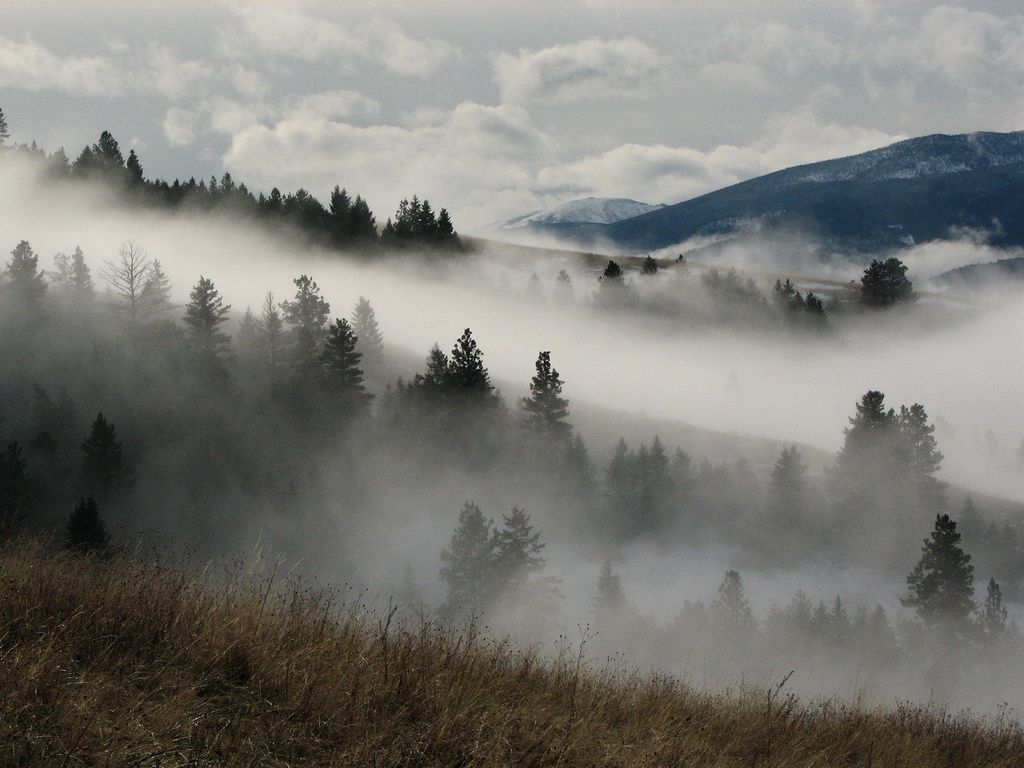Radiation fog transforms vast open plains into ethereal landscapes, creating surreal scenes where earth and sky blend into a seamless white canvas of mystery.
🌫️ The Dance of Moisture and Temperature
When darkness falls over expansive grasslands and agricultural plains, a remarkable atmospheric phenomenon begins to unfold. Radiation fog, one of nature’s most captivating meteorological events, emerges from the intricate interplay between cooling surfaces and moisture-laden air. This type of fog differs fundamentally from its coastal cousins, requiring specific conditions that make vast open plains the perfect stage for its mystical performance.
The formation process begins with radiative cooling—a phenomenon where the earth’s surface releases heat accumulated during daylight hours back into the atmosphere. Without the moderating influence of cloud cover, this heat escapes rapidly into space, causing ground temperatures to plummet. As the surface cools, it chills the air molecules immediately above it, creating a temperature inversion where cooler air sits beneath warmer air layers.
In open plains, this cooling effect operates with remarkable efficiency. The absence of urban structures, dense forests, or significant topographical barriers allows for uniform heat radiation across vast expanses. This uniformity creates ideal conditions for widespread fog development that can stretch for hundreds of kilometers, transforming entire landscapes into ghostly domains.
Why Plains Become Fog Factories
The unique characteristics of open plains make them particularly susceptible to radiation fog formation. These expansive landscapes possess several features that contribute to intense fog development, creating conditions rarely matched in other geographical settings.
First, the unobstructed horizon allows for maximum radiative cooling. Without mountains, buildings, or dense vegetation to absorb and re-radiate heat, the ground surface cools rapidly and efficiently. This creates a temperature gradient perfect for condensation.
Second, agricultural plains often contain significant moisture sources. Irrigation systems, crop transpiration, and soil moisture all contribute water vapor to the lower atmosphere. When combined with cooling temperatures, this abundant moisture readily condenses into fog droplets.
Third, the typically calm wind conditions found over plains during clear nights prevent the mixing of air layers. This stability allows the cold air to remain near the surface, maintaining the temperature inversion necessary for sustained fog formation.
The Perfect Recipe: Essential Ingredients
Creating radiation fog over vast plains requires a precise combination of meteorological ingredients. Understanding these elements helps explain why certain nights produce thick, persistent fog while others remain clear despite similar initial conditions.
- Clear skies: Cloud-free nights allow maximum heat radiation from the surface
- High relative humidity: Moisture content typically above 80% near the surface
- Light winds: Gentle breezes between 2-8 km/h prevent air mixing while distributing moisture
- Long nights: Extended cooling periods, especially during autumn and winter
- Moist soil: Recent rainfall or irrigation provides essential water vapor
- Stable atmosphere: Minimal vertical air movement maintains temperature inversions
From Dewpoint to Dreamscape: The Formation Timeline
The birth of radiation fog follows a predictable yet fascinating timeline that unfolds over several hours. This progression transforms clear evening conditions into dense morning fog through a series of measurable atmospheric changes.
As the sun sets, the cooling process begins almost immediately. Within the first hour after sunset, surface temperatures can drop several degrees. The rate of cooling depends on factors including surface type, initial temperature, and atmospheric moisture content. Bare soil and short grass cool more rapidly than water bodies or dense vegetation.
Between two and four hours after sunset, air temperatures near the surface approach the dewpoint—the temperature at which air becomes saturated and can no longer hold all its moisture as vapor. When these temperatures converge, water vapor begins condensing into microscopic droplets suspended in the air. This marks the initial fog formation.
During the midnight to pre-dawn hours, fog typically reaches its maximum thickness. Continued cooling and condensation feed the fog layer, which may extend from ground level to heights of several hundred meters. The fog often appears patchy initially, with denser concentrations in low-lying areas before expanding across the entire plain.
The Science Behind the Spectacle ✨
At the molecular level, radiation fog represents a phase transition of water from gas to liquid occurring in slow motion across massive spatial scales. Each tiny fog droplet, measuring roughly 10-20 micrometers in diameter, forms around a condensation nucleus—typically a particle of dust, pollen, or pollution.
These microscopic water spheres scatter light in all directions, creating the characteristic white appearance of fog. The density of droplets determines visibility, with thick fog containing millions of droplets per cubic meter. This scattering effect explains why fog appears white despite being composed of transparent water droplets—the collective scattering of all wavelengths of visible light produces the ghostly white veil.
The temperature inversion acts as a lid, trapping the fog layer beneath warmer air above. This stable configuration can persist for hours, preventing the fog from either rising into higher atmosphere or dissipating through evaporation. Only when solar radiation intensifies after sunrise does this stability break down.
Measuring the Mystery: Quantifying Fog Characteristics
Meteorologists use various metrics to characterize radiation fog events, providing quantitative measures of these qualitative experiences. Understanding these measurements helps predict fog formation and assess its impacts on activities across the plains.
| Parameter | Typical Range | Significance |
|---|---|---|
| Visibility | 50-1000 meters | Defines fog thickness and safety concerns |
| Liquid Water Content | 0.05-0.5 g/m³ | Indicates fog density and persistence |
| Droplet Size | 10-20 micrometers | Affects light scattering and deposition |
| Vertical Extent | 100-500 meters | Determines fog depth and duration |
| Duration | 3-8 hours | Impact on transportation and agriculture |
Regional Variations: Where Fog Reigns Supreme
Certain plains regions worldwide have earned reputations as radiation fog hotspots, where atmospheric conditions frequently conspire to produce these mystical mists. These areas share common geographical and climatological features that favor persistent fog formation.
The Great Plains of North America experience frequent radiation fog events, particularly during autumn and early winter. The Central Valley of California sees dense tule fog—a local term for radiation fog—that can persist for days, significantly impacting agriculture and transportation. These fog events have shaped regional culture and economy for generations.
The Pampas of South America, stretching across Argentina and Uruguay, witness similar phenomena. The flat terrain and agricultural landscape create ideal conditions for extensive fog formation. Local meteorological services track these events carefully due to their impacts on farming operations and road safety.
European plains, including the Po Valley in Italy and the North European Plain, regularly experience radiation fog. Historical records document fog events affecting these regions for centuries, influencing everything from military campaigns to agricultural practices.
Ecological Impact: Nature’s Response to Fog 🌱
Radiation fog profoundly influences ecosystems across open plains, affecting plant life, animal behavior, and soil conditions. Far from being merely atmospheric curiosities, these fog events play crucial roles in environmental processes that sustain grassland and agricultural ecosystems.
Plants in fog-prone regions have evolved strategies to capture and utilize fog moisture. Leaf structures may feature specialized surfaces that facilitate condensation collection, supplementing root-absorbed water during dry periods. This fog drip can contribute significantly to local hydrology, providing moisture equivalent to light rainfall.
Wildlife behavior changes dramatically during fog events. Birds delay morning flights, mammals alter foraging patterns, and predator-prey dynamics shift as visibility drops. Some species exploit fog conditions for hunting, while others seek shelter until visibility improves. These behavioral adaptations demonstrate fog’s integration into ecosystem functioning.
Soil processes also respond to fog presence. Condensation on vegetation eventually drips to the ground, providing surface moisture that supports microbial activity and seed germination. In semi-arid plains, this fog-derived moisture can be critical for maintaining biological activity during dry seasons.
Human Dimensions: Living with the Mist
For communities inhabiting fog-prone plains, these atmospheric phenomena represent both challenges and opportunities. Understanding and adapting to radiation fog has been essential for settlement, agriculture, and transportation across these regions.
Transportation safety emerges as the most immediate concern during dense fog events. Reduced visibility dramatically increases accident risks on highways that cross open plains. Modern responses include fog warning systems, variable speed limits, and specialized road lighting designed to penetrate fog more effectively than conventional systems.
Agricultural operations must account for fog’s dual nature—beneficial moisture delivery balanced against delayed fieldwork and disease risks. Fog droplets can facilitate fungal pathogen spread on crops, requiring careful disease management strategies. However, fog also reduces frost risk by maintaining slightly warmer temperatures and provides supplemental moisture during critical growth stages.
Aviation faces significant challenges from radiation fog. Airport operations may be suspended or severely restricted during dense fog, requiring sophisticated instrument landing systems and pilot training for low-visibility approaches. Plains airports particularly vulnerable to fog have invested heavily in fog prediction and management technologies.
Cultural Significance: Fog in Art and Imagination
Beyond practical concerns, radiation fog holds a special place in cultural consciousness of plains regions. Artists, writers, and photographers have long been captivated by fog’s transformative effects on familiar landscapes, using it as metaphor and subject matter.
Regional folklore often features fog prominently, with stories explaining its origins through mythology or associating it with supernatural phenomena. These cultural narratives reflect both respect and unease toward fog’s power to obscure and transform the environment.
Contemporary landscape photography celebrates fog-shrouded plains as subjects of ethereal beauty. The simplified compositions—reduced to essential forms by limited visibility—appeal to minimalist aesthetics while conveying a sense of mystery and contemplation.
Climate Change: An Uncertain Future for Fog 🌍
As global climate patterns shift, scientists are investigating how radiation fog frequency and characteristics may change across plains regions. Preliminary research suggests complex interactions between temperature trends, precipitation patterns, and fog formation potential.
Warmer nighttime temperatures could reduce the radiative cooling necessary for fog formation, potentially decreasing fog frequency in some regions. However, increased atmospheric moisture from enhanced evaporation might counteract this effect, maintaining or even increasing fog occurrence under certain conditions.
Changes in agricultural practices responding to climate shifts may also influence fog patterns. Altered irrigation schedules, different crop types, and modified land use all affect local moisture availability and surface characteristics—key factors in radiation fog development.
Long-term monitoring programs are now tracking fog trends across multiple plains regions, building databases that will eventually reveal whether fog patterns are changing systematically. These efforts face challenges including historical data limitations and the influence of urbanization and land use changes that complicate climate change signals.
Forecasting the Fog: Prediction Technologies
Modern meteorology employs sophisticated tools to predict radiation fog formation, timing, and dissipation. These forecasting capabilities have improved dramatically in recent decades, though significant challenges remain in capturing fog’s localized and sensitive nature.
Numerical weather prediction models now include specific fog parameterizations that simulate the physical processes driving fog formation. High-resolution models can resolve temperature and moisture variations at scales of a few kilometers, enabling increasingly accurate fog forecasts for specific plains regions.
Satellite observations contribute valuable data, though detecting radiation fog from space presents challenges. Fog appears similar to low clouds in satellite imagery, requiring careful analysis to distinguish between them. Specialized algorithms combining multiple satellite channels help identify fog signatures more reliably.
Ground-based observation networks remain essential for fog monitoring and model verification. Automated weather stations across plains regions continuously measure temperature, humidity, and visibility—data streams that feed both forecast models and validation studies improving prediction accuracy.
Tomorrow’s Mist: Research Frontiers and Knowledge Gaps
Despite centuries of observations and decades of scientific study, radiation fog continues to present research challenges and opportunities for new discoveries. Current investigations are expanding understanding of fog processes and their broader implications.
Researchers are exploring fog’s role in atmospheric chemistry, recognizing that fog droplets provide unique environments for chemical reactions. Pollutants dissolved in fog water undergo transformations affecting air quality and deposition patterns, with implications for environmental health across plains regions.
The interaction between fog and the surface energy budget receives increasing attention. Fog alters radiative transfer and energy fluxes in complex ways, potentially affecting local climate and the coupling between atmosphere and surface—processes important for understanding regional climate dynamics.
Advances in measurement technology enable unprecedented detailed observations of fog microstructure. Instruments now characterize individual droplet sizes, chemical compositions, and spatial distributions with remarkable precision, revealing variability previously hidden within the fog’s uniform appearance.
Embracing the Enigma: Finding Beauty in the Blur
Radiation fog over vast open plains represents one of nature’s most accessible yet profound phenomena—a transformation available to anyone willing to venture into the early morning mist. The temporary obliteration of familiar landmarks, the muffling of sounds, and the soft light filtering through suspended water droplets create experiences both disorienting and deeply peaceful.
Understanding the science behind fog formation enhances rather than diminishes its aesthetic and emotional impact. Knowing that each droplet formed around a microscopic particle, that temperature inversions trap the fog layer, that molecular processes scale up to landscape-level effects—this knowledge adds depth to the sensory experience of standing within the mist.
As climate and land use continue evolving, the fog patterns characterizing plains regions may shift in ways we cannot yet fully predict. This uncertainty makes each fog event more precious—a reminder of atmospheric complexity and the dynamic nature of the environments we inhabit. The mystical mist will continue unraveling its secrets to those who observe carefully, whether through scientific instruments or simply through patient presence within its ethereal embrace.
Toni Santos is a visual storyteller and artisan whose creations celebrate the poetry of the natural world. Through his thoughtful artistic lens, Toni captures the elegance of botanical forms, transforming them into meaningful expressions of symbolism, resilience, and timeless beauty.
His journey is deeply rooted in a passion for flora and the mysteries they carry. From the shape of a petal to the curve of a vine, each design Toni brings to life reflects a deeper narrative — one of growth, transformation, and harmony with nature. Whether crafting symbolic floral jewelry, enchanted botanical illustrations, or seasonal visual studies, Toni’s work evokes the quiet magic found in Earth’s most delicate details.
With a background in handcrafted artistry and visual design, Toni blends technique with intention. His creations do more than decorate — they speak, often inspired by ancient meanings behind flowers, the cycles of the seasons, and the invisible bonds between nature and spirit.
As the creative voice behind Vizovex, Toni shares this botanical journey with the world, offering curated stories, handcrafted collections, and thoughtful articles that help others reconnect with nature’s symbolism and artistic essence.
His work is a tribute to:
The quiet power of flowers and their messages
The art of visual symbolism in everyday life
The beauty of slowing down to see what’s hidden in plain sight
Whether you’re an artist, a nature lover, or someone drawn to the deeper meanings behind the natural world, Toni welcomes you to explore a space where aesthetics meet soul — one petal, one story, one creation at a time.





